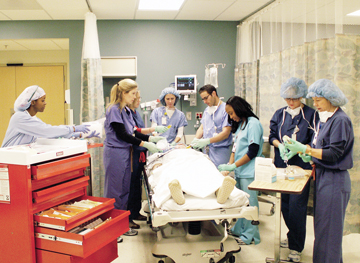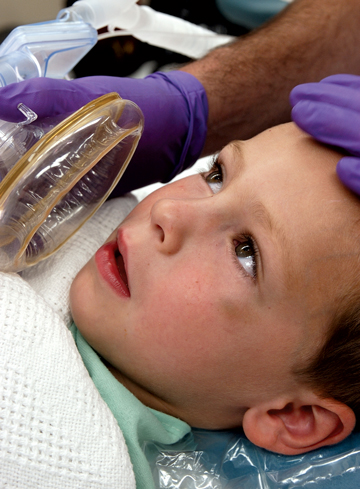April 25, 2024
Growing demand for anesthesia services at ASCs is being met with a dwindling supply of anesthesia providers....
This website uses cookies. to enhance your browsing experience, serve personalized ads or content, and analyze our traffic. By clicking “Accept & Close”, you consent to our use of cookies. Read our Privacy Policy to learn more.
By: Ronald Litman
Published: 8/10/2020
MYTH #1: A post-op fever is indicative of MH
FACT: Many clinicians worry that MH may begin in the postoperative period with a fever as the presenting sign, and anesthesia providers are typically taught that MH can occur as late as 48 hours after surgery.
This is incorrect. Postoperative hyperthermia (a temperature > 38 ?C) without additional signs of MH is relatively common and is not typically associated with an eventual diagnosis of MH. Nearly all cases of postoperative MH begin to demonstrate
signs of onset within 10 minutes of discontinuing the triggering agent (volatile anesthesia gas).
MYTH #2: A high fever many hours after administration of succinylcholine is a symptom of MH
FACT: A common call we received on the MHAUS hotline involved scenarios similar to this one: An elderly patient with underlying respiratory disease presents to the emergency room with pneumonia and respiratory
distress. The docs there determine the patient is in respiratory failure and requires tracheal intubation. Etomidate and succinylcholine are administered, intubation is performed and the patient is sent to the intensive care unit to receive
further treatment. Later that night, the patient develops a high fever, sometimes exceeding 40 ?C. The ICU staff believes a patient with a high fever who received succinylcholine could be experiencing MH. Although the administration of
succinylcholine alone is rarely associated with MH, there are no known cases where MH begins to develop many hours later — and manifest solely as a high fever — without additional signs of MH. This patient's uncommonly high fever
is most likely related to their underlying infectious process. We are not aware of any of these cases that ultimately proved to be caused by MH.
MYTH #3: MH does not occur after administration of succinylcholine alone
FACT: Most MH cases are associated with the administration of a volatile anesthetic gas with or without succinylcholine. Many anesthesia providers are under the impression that because the use of succinylcholine
is so common — and MH is so unusual — that the two are not related. Although rare, we are aware of cases of proven MH that occurred after administration of succinylcholine alone. However, unlike Myth #2, the clinical syndrome
usually manifests as marked muscle rigidity (generalized or confined to the masseter muscles), respiratory and metabolic acidosis, rhabdomyolysis and high temperature.
MYTH #4: Patients with a family history of MH are susceptible only if MH occurred in a first-degree relative
FACT: I recently took care of a child whose mother's great uncle had proven MH susceptibility. Some anesthesia providers believe that since no one else in the family between these generations developed MH,
then the child has the same risk of MH as the general population. Although a classic Mendelian inheritance of MH is an oversimplification, MH susceptibility is inherited in an autosomal dominant pattern. This means that having a mutation
in only one copy of the responsible gene (one parent) is enough to confer MH susceptibility. With every generation, the risk of MH susceptibility decreases by 50%. Using a conservatively high prevalence of MH variants of approximately
1 in 1,500 in the general population, it would take approximately 10 generations to decrease the calculated familial risk to be similar to that of the general population. As this example illustrates, any familial history within 10 generations
(essentially everyone) should be cause for suspicion of MH susceptibility. In my patient's case, the causative variant may have started five generations away, which puts the child's risk at about 3%, still much higher than the general
population. Therefore, the child should receive MH precautions, meaning anesthesia with non-triggering agents.

MYTH #5: MH occurs mainly in children
FACT: Because MH is a genetic disorder, its susceptibility has nothing to do with age. It may manifest itself earlier when children have surgeries, but epidemiologic studies demonstrate that the median age of an
acute MH reaction is about 19 years. This means that about half of all MH reactions occur in children and half occur in adults. While we're on the subject, a previous safe anesthetic with triggering agents is no guarantee that MH won't occur
again in that patient when triggering anesthetics are administered. Approximately half of patients who develop MH have had one or two uneventful exposures to triggering agents. In fact, MHAUS is aware of a patient with confirmed MH who had
received approximately 30 anesthetics before their triggering event.
MYTH #6: The MH-related mortality rate is 10% to 15%
FACT: Some textbooks and database-driven studies have estimated that approximately 10% to 15% of acute MH events will ultimately prove fatal. This estimate isn't accurate based on calls to the MHAUS hotline. Professionals
who man the hotline are alerted to one to two likely cases of MH per week. But we're also aware of only one to two deaths from MH every couple years. Those numbers are likely underestimates because of the cases that we're unaware of, but at
most the mortality is likely less than 2%. This is good news. It means that the combination of MH awareness among surgical teams and the success of treatment with dantrolene can reliably reduce MH mortality to historically low numbers. In
the future, when whole exome screening becomes more cost effective and all patients are screened for MH causative variants before surgery, the incidence of MH events will be close to zero. There will, however, continue to be rare reactions
in patients with previously unknown pathogenic variants.
MYTH #7: MH susceptibility is associated with Duchenne and Becker muscular dystrophy
FACT: Many clinicians fear hypotonic patients are at risk for MH susceptibility. Almost all MH susceptibility is conferred by inheritance of a pathogenic variant on the RYR1 gene located on chromosome 19 (very
rare cases of MH susceptibility are associated with pathogenic variants of the CACNA1S ?and STAC3 genes). These ryanodinopathies consist mainly of the phenotypes previously described as central core disease, multiminicore
disease and King-Denborough syndrome.
The myth, however, stems from the belief that sudden or delayed rhabdomyolysis associated with the administration of triggering agents represents MH. This reaction — while having some features in common with MH — actually represents muscle breakdown in certain susceptible patients, as opposed to the predominantly hypermetabolic MH reaction. For example, it is now well known that patients with Duchenne or Becker type muscular dystrophy may develop life-threatening or fatal hyperkalemia associated with rhabdomyolysis when administered volatile agents or succinylcholine. Other types of rare diseases associated with muscle breakdown — such as CPT2 deficiency, McArdle's disease or myoadenylate deaminase deficiency — may be associated with rhabdomyolysis from administration of MH triggering agents. Some patients with a history of exaggerated rhabdomyolysis upon exposure to heat, exercise or administration of statin medications, may be susceptible to either MH or these non-MH-related muscle breakdown reactions when they receive triggering anesthetics.
MYTH #8: MH susceptibility can be ruled out with a genetic screening test
FACT: Genetic screening is only useful when it reveals a known MH-causative variant because there are too many suspected MH variants that are yet unknown. At the present time, a known causative variant will be
present in about 50% of biopsy-proven MH patients. That means the causative variant in the other half of the these patients is presently unknown and will remain undetected from a negative genetic screen. The only current and reliable way to
rule out MH susceptibility is by a negative contracture biopsy test. But this impractical method requires the patient to undergo a fresh muscle excision (usually from the thigh) at one of only five specialized sites in North America.

MYTH #9: MH susceptible patients cannot be anesthetized in freestanding surgery centers
FACT: Many clinicians believe that a patient who is known or suspected to be MH susceptible should not receive a trigger-free anesthetic in a freestanding surgical facility because the center will lack the resources
to properly treat the reaction if it does occur. The chance that they will develop MH under these conditions is close to zero. On the other hand, many thousands of patients with unknown MH susceptibility receive triggering anesthetics daily.
The chance that one of these patients will develop MH in a freestanding center, while rare, is still much higher than the patient with suspected or known MH susceptibility who receives a non-triggering agent. Many anesthesia providers avoid
caring for these patients in freestanding centers due to fear of the unknown and the unwillingness (perhaps justified) to interfere with the normal throughput of the busy surgery schedule to complete the additional steps needed to safely care
for these patients, such as thoroughly cleaning the anesthesia machine's breathing circuit and using total intravenous anesthesia.
MYTH #10: Following an uneventful trigger-free anesthetic, MH susceptible patients should be observed for four hours in the PACU before discharge
FACT: Many ambulatory surgical facilities will prolong the discharges of MH susceptible patients for several hours to guard against a possible delayed postoperative reaction. This isn't necessary. We are not aware
of any cases of delayed MH (see Myth #1), especially in patients who receive a non-triggering anesthesia technique. MH susceptible patients who are recovering as expected after surgery can be sent home as soon as they meet normal discharge
criteria. OSM
Growing demand for anesthesia services at ASCs is being met with a dwindling supply of anesthesia providers....
Improvements in both workflow and staff attitudes are part of a leader’s responsibilities, but your interventions in these areas don’t need to be major to make...
The ASC market continues its rapid growth. In 2023, roughly 116 new ASCs opened in the U.S., many of which were orthopedic-specific in nature....